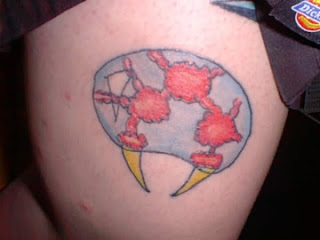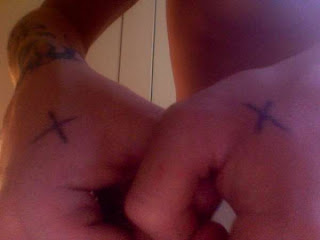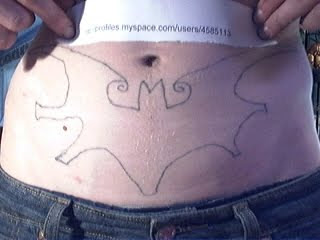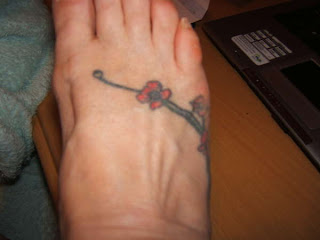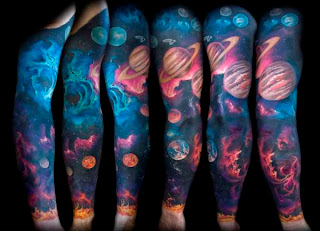Friday, July 30, 2010
Devil Tattoos and Evil Tattoos: Soul Of Tattoo

Devil tattoos are representations of a supernatural entity, who, in most Western religions, is the central embodiment of evil. This entity is commonly referred to by a variety of other names, including Satan, Asmodai, Beelzebub, Lucifer and Mephistopheles. In the tradition of the Christian Church, Lucifer was an archangel, who had God’s favor as the first angel among equals, but because of his vanity, hubris and weakness of character fell so far from God’s grace that he was literally cast out of Heaven when he led other angels in revolt. As the devil, Lucifer is a symbol for chaos, and a wild, uncontrollable spirit cursed with all the vices and worst aspects of the human condition.

Images of Satan as being red, having horns, cloven hooves and a tail are all efforts by a Church hierarchy to literally demonize the image of the fallen Lucifer. A devil tattoo symbolizes a mischievous, lascivious, and perhaps slightly wicked nature with a predisposition towards all manner of sinful behavior and other vices! It is also the symbol for lust in certain pagan religions such as Satanism.

Despite it’s obvious connotations of being evil, many people merely choose a devil tattoo because their personality is a bit mischievous. Some devil depictions have nothing to do with hell and condemnation, but rather are cute and cuddly.
Wednesday, July 28, 2010
How to Choose Wing Tattoo Designs
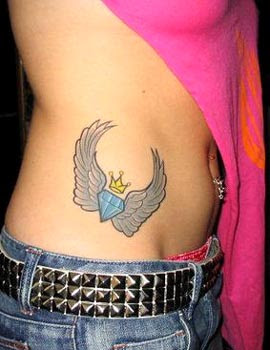
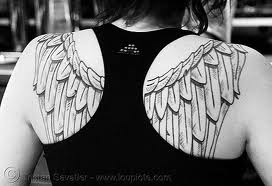

Placed popularly on the back, sometimes on the chest, wing tattoos are some of the most popular choices for women that are seeking to get a tattoo. There are a wide variety of options when it comes to styling wing tattoos and many choices that can be made to customize the appearance of the tattoos. Wing tattoos are popularly placed directly on, or above the shoulder blades on the back and can range in a variety of sizes, depending on the design that has been chosen.
How large would you like the wing tattoos? Depending on the size of the back and the area in which the wing tattoos are placed, there are various options that are available for the wing tattoos. The larger the wing tattoos on the back, the larger the area of the back that will be covered with tattoos.
Larger wing tattoos that are created on the back can often go from the shoulder blades to above the buttocks. These types of wing tattoos are popular with girls seeking a large tattoo, a back piece – but still seeking something girl. This is a great way to create a large tattoo that remains girl, as most often do not.
There are a variety of ways that the wing tattoos can be designed, either with other tattoos in the middle of the wing tattoos or simply choosing to take advantage of the wing tattoos alone. Working with a tattoo artist, they will often draw a sketch and show it to you on the skin before starting the work. This can help to gauge the size of the wings.
Wing tattoos have been said to have a variety of meanings. One of the most popular meanings which are associated with wing tattoos is the freedom that spiritually comes from having a set of wings.
The Meaning of Angel Wing Tattoos
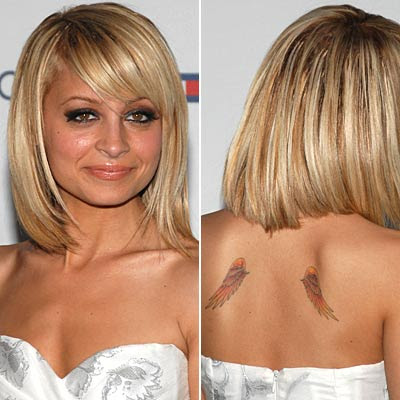

With the rise in popularity of angel wing tattoos, it leaves many people wondering about the meaning behind these popular wings that are used in a variety of designs and most often placed on the back of the body. What is the meaning behind these tattoos and where can the origins of the angel wing tattoos be found within the history of tattooing?
The meaning of the angel wing tattoos are pretty straight forward and include the individual being able reach new heights in their life through the use of these wings which have come from the back. Although real angels are not depicted having wings in the bible, there are many other publications in the form of books and movies whic

h have made these types of tattoos increasingly popular throughout pop culture.
Other people have decided to get the angel wings to establish their wish to do good within their life and their wish to good within their soul. These types of tattoos are often used to portray a goodness in which the individual feels emanates from the body. It is a very personal tattoo choice and therefore can be seen in a variety of instances. While choosing the angel wing tattoos, there are also many people who have chosen to get the angel wing tattoos as they have lost someone special to them, symbolizing the presence of a guardian angel.
Larger angel wing tattoos are often seen on the back and can reach from above the shoulder blades all of the way to the lower back. There are often smaller versions which can be placed on the upper back, as well as other parts of the body – which are not as popular as the larger versions.
Angel Wing Tattoo:Soul Of Tattoo
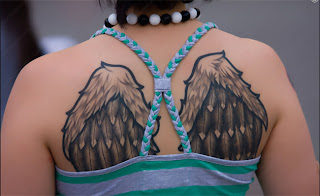
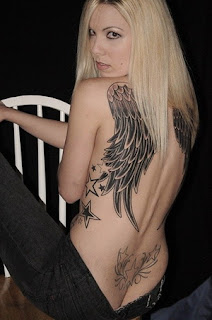
This is one type of traditional tattoo that will not go out of style. The tattoo remains a clear choice for those getting their first tattoo, or for those seeking something different. Angel wing tattoos are stylish and trendy, but timeless.
One of the greatest things about angel wing tattoos is the fact that they can be customized through the entire process. They can be made to appear large or small and appear modern, or traditional wings. There are many patterns and shapes which can be implemented into the wings and the tattoo can often be completed within as little as one visit to the tattoo shop.
How to Choose Angel Wing Tattoos
Friday, July 23, 2010
Japanese Tattoos 04:Soul Of Tattoo



Despite the fact that tattooing is still considered rather on the taboo side in Japan, those who seek out either rebellion or a sense of beauty will find themselves drawn to the mystical, unique and splendid style of Japanese tattoos. This style will continue to have a draw for its variety and its colorful nature.
Japanese Tattoos 04:Soul Of Tattoo



Japanese Tattoos 03:Soul Of Tattoo






Japanese Tattoos, Designs, Pictures

Japanese Tattoos

Japanese Tattoos
geisha tattoos exotic 03



Though there is no set definition to what geisha tattoos may symbolize, it is pretty easy to understand why some may see them as an emblem for elegance, striking beauty and hundreds of years of remarkable artistry.
geisha tattoos,designs,and pictures


geisha tattoos exotic 02


Many people like to use geisha tattoos that utilize the entire splendor of a traditional geisha or maiko (an apprentice whose appearance differs slightly from a full-fledged geisha). These are generally done in a portrait style, and depict the elegant figure with a porcelain-white complexion; small, brightly colored and bow-like lips; brilliantly hued kimono and one of the four shimada hairstyles (most commonly a style called ‘momoware,’ which looks something like a divided peach, and bears a good deal of colorful ornamentation).
geisha tattoos exotic


Wednesday, July 21, 2010
Shark Tattoos

When considering shark tattoos, it is interesting to know the varieties of shark available for your use. Two of the most favored are the great white (known for its enormous size and voracious appetite), and the hammerhead shark (not as commonly known for any particular viciousness, it is popular mainly due to its otherworldly, almost alien-like appearance). Although you may choose to use these very recognizable types, you may also go for a more unfamiliar variety of shark. One good example of this is the cookiecutter shark (also known as the cigar, or luminous shark). This creature, like the hammerhead, seems almost supernatural, and would make for a very different piece of art. They are relatively small in size, sport green pupils, a perfectly rounded and prominent lower jaw with sharp teeth, and an underbelly that glows with a blue and green luminescence.
Shark tattoos are not regularly seen by themselves, but are often placed with other undersea life, and a vast array of nautical themes. A shark chasing a small fish, using its large bite to free itself from the arms of an octopus, or prowling around the sides of a ship are all frequently displayed images. Shark tattoos may also depict some of the vast mythology that they carry. You could easily use the Australian aborigine’s myth of Bangudja (half man, half tiger shark) in battle with the dolphin man, leaving the rocks of the Gulf of Carpentaria red. You may also try a depiction of the myth from the indigenous people of Solomon; Dakuwanga, a shark god, was said to devour lost souls. This depiction could show translucent human figures swimming in a dark ocean, whilst being stalked by a large, impressive shark. One more example would be that of Lamia (a Greek daimon whose name means ‘lone shark’) floating in the sea, carrying her child Akheilos (or, ‘the Lipless One’, who was said to be transformed into a shark by Aphrodite).







